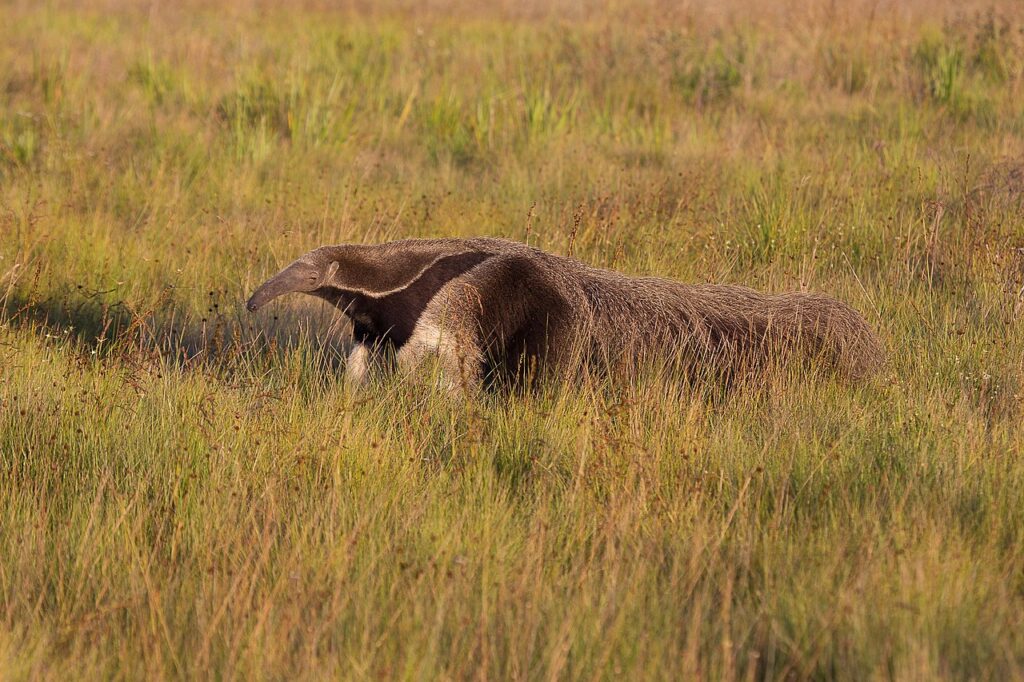The Giant Anteater (Myrmecophaga tridactyla) is an unusual and captivating mammal native to Central and South America. Well-adapted for its unique lifestyle, this species is a master of the rainforest floor, yet it faces significant threats that have led to its status as a vulnerable species. This article will delve into the biology, habits, and challenges of the Giant Anteater, shedding light on the importance of its conservation.
Biology and Unique Characteristics
The Giant Anteater, sometimes called the “ant bear,” is an intriguing blend of biological adaptation and specialization. At first glance, its elongated snout, large bushy tail, and powerful claws make it a truly distinct creature among mammals. Standing up to 1.2 meters at the shoulder, the Giant Anteater’s body length ranges between 5.97 and 7.12 feet, with males typically larger than females. Its long, narrow head equipped with a tongue that can extend up to 60 cm, is an adaptation for consuming its primary food source: ants and termites.
Interestingly, the Giant Anteater has no teeth but instead uses its long tongue coated with sticky saliva to gather up to 30,000 insects per day. Its keen sense of smell, which is 40 times more powerful than that of humans, aids in locating insect nests, and its strong forelimbs and sharp claws serve as effective tools to tear open mounds and logs.

Habitats and Behaviors
The Giant Anteater is predominantly found in multiple habitats such as rainforests, grasslands, and deciduous forests. It is a solitary creature, with territories often overlapping among individuals. They are mainly terrestrial but are adept swimmers and climbers when the situation demands.
Giant Anteaters lead a mostly nocturnal and crepuscular life to avoid extreme heat, although they can be active during the day in areas with less human activity. A fascinating aspect of their behavior is their sleeping habit. They curl up with their bushy tail covering their bodies, mimicking a termite mound or a fallen log, thereby camouflaging themselves from predators.
Threats faced by the Giant Anteater
Classified as vulnerable by the International Union for Conservation of Nature (IUCN), the Giant Anteater is facing a decline in its population due to various threats. Habitat destruction is the most significant threat, with large areas of their habitat lost to agriculture, particularly cattle ranching, and urban development. Hunting for meat and traditional medicine, as well as deaths from road traffic and fires, also contribute to their declining numbers.
How is Giant Anteater being conserved?
Efforts to protect and conserve the Giant Anteater focus on habitat conservation, research, and awareness-raising. Protected areas have been established to conserve the natural habitats of Giant Anteaters. In areas where their natural habitat has been destroyed, efforts are underway to create wildlife corridors that allow them safe passage and access to food sources.
Research initiatives aim to understand better the biology and ecology of Giant Anteaters, which can inform effective conservation strategies. Satellite tracking, for instance, provides information on their movement patterns and habitat use, which is crucial for their protection.
Educating the public about the importance of the Giant Anteater to the ecosystem is another crucial conservation measure. By increasing awareness of the Giant Anteater’s ecological role and the threats it faces, public support for conservation measures can be boosted.
Conclusion
The Giant Anteater is an extraordinary creature that has evolved to fill a unique niche in the ecosystems of Central and South America. Its decline is a significant concern, indicative of broader environmental challenges impacting the health of our planet’s ecosystems. However, with continued research and conservation efforts, there is hope for the Giant Anteater.
By protecting their habitats, raising awareness about their ecological importance, and mitigating the threats they face, we can ensure that this unusual and fascinating mammal continues to roam the rainforest floor for generations to come. The Giant Anteater’s story serves as a reminder of the delicate balance of nature and our shared responsibility to safeguard our planet’s biodiversity. After all, in protecting the most vulnerable species, we contribute to the overall health and resilience of our global ecosystem, underscoring the interconnectedness of all life on Earth.
Help us Help Them! Think Wildlife Foundation is a non profit organization with various conservation initiatives. Our most prominent campaign is our Caring for Pari intiative. Pari is a rehabilitated elephant at the Wildlife SoS Hospital. 25% of the profits from our store are donated to the elephant hospital for Pari. Other than buying our wonderful merchandise, you could donate directly to our Caring For Pari fundraiser.
Written by: Sanghmitra Singh
